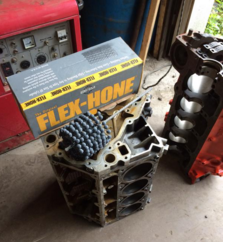 There are plenty of myths about high-performance engines. For example, some drivers claim that most engine wear happens at high speeds under tough racing conditions. In fact, the one or two seconds before full lubrication at startup is where most engine wear occurs. Similarly, some mechanics say that more zinc in your engine oil is always better. Yet too much zinc can interfere with friction modification.
There are plenty of myths about high-performance engines. For example, some drivers claim that most engine wear happens at high speeds under tough racing conditions. In fact, the one or two seconds before full lubrication at startup is where most engine wear occurs. Similarly, some mechanics say that more zinc in your engine oil is always better. Yet too much zinc can interfere with friction modification.
There are some powerful myths about engine hones, too. Some mechanics say that you should never use BRM Flex-Hone® tools with Nikasil cylinders. “Never”, however, is incorrect. While it’s true that BRM’s engine hones are not recommended for all Nikasil cylinders, you can use aluminum oxide (AO) Flex-Hone® tools to deglaze some (but not all) non-ported Nikasil cylinders.
So what kind of Nikasil cylinders are good candidates for flexible honing? Let's take a look.
Nikasil Cylinders and Flex-Hone® Tools
Nikasil is a nickel-plated silica carbide coating that’s applied to the walls of some engine cylinders. Invented by MAHLE nearly 40 years ago, Nikasil reduces friction and wear, especially in aluminum bores. Nikasil liners improve oil retention, but some engine mechanics avoid this high-performance plating material.
Because Nikasil coatings are thin, honing stones can remove too much of the cylinder liner. Thank goodness rigid hones aren’t your only option. Does that mean that Flex-Hone® tools are a good choice for every Nikasil cylinder? Maybe! If the Nikasil plating is chipped, nicked, cut-through, has worn spots or is showing signs of wear, do not use Flex-Hone® tools. Instead, strip and re-plate the coating, or replace the cylinder altogether. Again, because Nikasil platings are very thin and very hard, honing will expose any existing damage. If the plating looks to be in good condition but needs a new surface, the Flex-Hone is a great choice.
If you're unsure of the condition of your Nikasil cylinders, it's important to inspect them thoroughly to ensure the plating's integrity before you start honing. Flex-Hone® tools are not designed for heavy-duty material removal, but they do work like an abrasive scrub brush that removes combustion by products and the "glaze" that forms on used cylinder walls. By removing this glaze, Flex-Hone tools restore cylinder wall surfaces to an optimum condition.
BRM Glaze Breaker Hones
In automotive engines, the up-and-down movement of the pistons can create an overly smooth finish that causes the piston rings to skate along the surface and fail to seat and seal properly. Cylinder wall glazing can also prevent engine oil from adhering to surfaces. In addition to breaking the glaze then, BRM’s engine hones impart a surface finish with oil-retaining valleys for optimum lubrication and reduced engine wear.
For deglazing Nikasil cylinders, BRM recommends flexible cylinder hones with 240-grit AO abrasive. For cast iron engine cylinders, use silicon carbide (SC) abrasive instead. BRM Flex-Hone® tools are easy-to-use and require no special training, but choosing the right abrasive type and grit size are important. For complete information about Flex-Hone® technology, download the Flex-Hone® Resource Guide.









